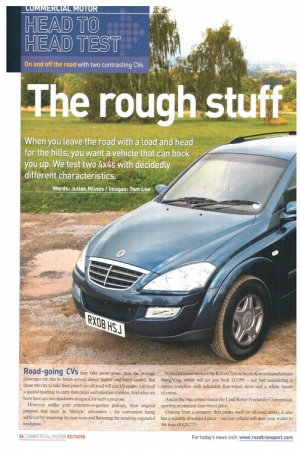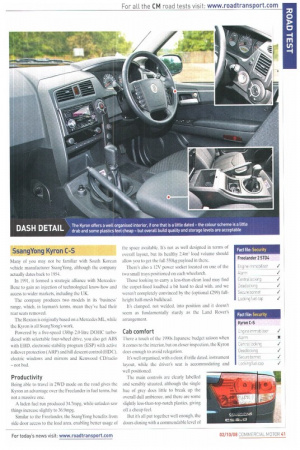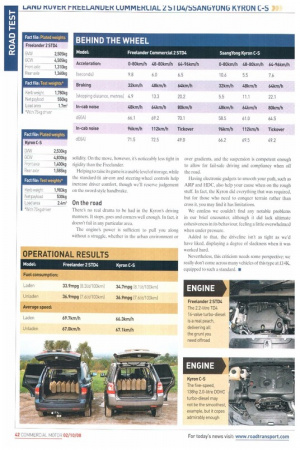When you Leave the road with a Load and head
Page 36

Page 38

Page 40

Page 41

Page 42

If you've noticed an error in this article please click here to report it so we can fix it.
for the hills, you want a vehicle that can back you up. We test two 4x4s with decidedly different characteristics.
Words: Julian Manes / Images: Tom Lee Road-going CVs may take more abuse than the average passenger car due to hours served, driver 'habits' and loads carried. But those who try to take their panel van off-road will quickly realise you need a special machine to carry that cargo and maintain traction. And what we have here are two machines designed for such a purpose.
However, unlike your common-or-garden pickups, their original purpose was more 'as offroaders the conversion being achieved by removing the rear seats and flattening the resulting expanded loacIspace. in the red cornerwe have the Kyron CS from South Korean manufacturer-, SsangYong, which will set you back £13.995 not bad considering. comes complete with selectable four-wheel drive and a whole bunch of extras.
And in the blue corner stands the I And Rover Freelander Commercial, sporting permanent four-wheel drive.
Coming from a company that prides itself on off-road ability, it also has a suitably developed price out test vehicle will dent your wallet to the tune of £20.775.
FreeLander Commercial 2 STDR
The second-generation Freelander Commercial was launched earlier this year, and comes in S and XS specs.
Both are powered by a 2.2-litre TD4 16-valve turbodiesel with common-rail engine, which is also used (ironically) in Ford's Transit.
Producing 158hp and 400Nm of torque, it's linked to a six-speed shift and full-time four-wheel-drive system, with the XS version also benefiting from Land Rover's Terrain Response System, which allows you to adjust the 4WD system to the happenings below.
Standard equipment for the base S model (and CM test vehicle) includes electric heated door mirrors, alarm, 16in alloy wheels. CD/radio with six speakers, auxiliary heater, manual air-con, and tyre-repair system.
The more extravagantly adorned XS gets 17in alloys, cruise control cloth/leather seats, automatic headlamps, rain-sensing wipers. automatic air-con, Alpine CD system with nine speakers. remote audio controls, front and rear parking sensors and puddle lamps on the doors and door mirrors to stop your wellies getting wet.
Priced at £20,775 for the S and E25,595 for the XS, it doesn't come cheap.
Productivity With its slab sides and permanent 4WD, fuel economy is seemingly not a priority for the Freelander, so a return of 33.9mpg for a laden fuel run was better than expected. and this improved to 36.9mpg when unladen.
Its box-like proportions work in its favour when it comes to the load part, allowing for a volume of 1.7m3and a payload of 550kg. They also make for easy tilling, enabling you to best utilise the space available.
Protecting the floor is a heavy-duty standard-fit rubber mat, which, as well as absorbing any knocks, helps grip the load on the move, which can also be secured via four loadlashing points, while the standard full-length, half-mesh bulkhead protects the occupants. Access from the rear is generous enough, avoiding any head clashing on the tailgate, while the panelled rear side doors allow easy entrance to the front of the load area.
Cab comfort
Unlike many modern off-roaders with their jazzy-snazzy' interiors, civility is the order of the day when it comes to the Freelander's cabin. Sit inside, get comfortable—thanks in part to the accommodating seat and steering-wheel adjustment — and survey your environment.
Nothing jumps out at you, but there's no need to squint to find a particular function or button — it's all clearly labelled and where you'd expect to find it.
This may not sound like a revelation in design terms, but you can imagine that when trooping through dark country paths in the latest, new and improved, version of the British downpour, you'd want to hit a switch without thinking as you balance on a 45" angle.
This rather practical approach also means, however, that a slight dreariness in the plastics is evident, only broken up by a crazy slash of silver round the gearstick.
Storage levels are enough for most situations. You get door bins, a central cubby hole above the radio (presumably where the sat-nay goes), a glovebox and three various-sized cup-holders between the seats.
What helps complete the Land Rover's interior is the overall quality of fit and finish; something you're grateful for when bouncing over paths.
On the road
Although its main focus is its off-road capabilities. the Freelander still manages to deliver a rather satisfying on-road performance.
Composure is the core feature here, thanks in part to a chassis and suspension that don't completely give themselves over to allterrain compliancy.
The Freelander sticks to the road in a reassuring manner, changing direction without complaint, while at high speed it remains unaffected by crosswinds and undulations. However we did have mixed feelings over the steering. Accurate and quick in ratio it may be, but the strong centring means you have to measure your inputs at times.
Things get back on track with the driveline, the engine offers more than enough grunt to keep you moving briskly, matching well to the precise six-speeder.
All these attributes also make it a superior off-road machine. As soon as you hit the dirt, the Land Rover gives you to confidence to push on without concern for its dynamic limits. It covers ground in an almost nonchalant way, skipping over uneven surfaces at speed, without ever feeling stressed — and all the time insulating you from the outside elements due to its impressive build.
SsangYong Kyron C-S
Many of you may not be familiar with South Korean vehicle manufacturer SsangYong, although the company actually dates back to 1954.
In 1991 it formed a strategic alliance with MercedesBenz to gain an injection of technological know-how and access to wider markets, including the UK.
The company produces two models in its 'business' range. which, in layman's terms, mean they've had their rear seats removed.
The Rexton is originally based on a Mercedes ML, while the Kyron is all SsangYong's work.
Powered by a five-speed 138hp 2.0-litre DOHC turbodiesel with selectable four-wheel drive, you also get ABS with EBD, electronic stability program (ESP) with active rollover protection (ARP) and hill descent control (HDC), electric windows and mirrors and Kenwood CD/radio — not bad.
Productivity
Being able to travel in 2WD mode on the road gives the Kyron an advantage over the Freelander in fuel terms, but not a massive one.
A laden fuel run produced 34.7mpg, while unladen saw things increase slightly to 36.9mpg.
Similar to the Freelander, the SsangYong benefits from side door access to the load area, enabling better usage of the space available. It's not as well designed in terms of overall layout, but its healthy 2.4m load volume should allow you to get the full 550kg payload in there.
There's also a 12V power socket located on one of the two small trays positioned on each wheelarch.
Those looking to carry a less-than-clean load may find the carpet-lined loadbed a bit hard to deal with, and we weren't completely convinced by the (optional 1299) fullheight half-mesh bulkhead.
It's clamped, not welded, into position and it doesn't seem as fundamentally sturdy as the Land Rover's arrangement.
Cab comfort
There a touch of the 1990s Japanese budget saloon when it comes to the interior, but on closer inspection, the Kyron does enough to avoid relegation.
It's well organised, with a clear, if trifle dated, instrument layout, while the driver's seat is accommodating and well positioned.
The main controls are clearly labelled and sensibly situated, although the single hue of grey does little to break up the overall dull ambience, and there are some slightly less-than-top-notch plastics. giving off a cheap feel.
But it's all put together well enough, the doors closing with a commendable level of solidity. On the move, however, it's noticeably less tight in rigidity than the Freelander.
Helping to raise its game is a usable level of storage, while the standard-fit air-con and steering-wheel controls help increase driver comfort, though we'll reserve judgement on the sword-style handbrake.
On the road
There's no real drama to be had in the Kvron's driving manners. It stops, goes and corners well enough. In fact, it doesn't fail in any particular area.
The engine's power is sufficient to pull you along without a struggle, whether in the urban environment or over gradients, and the suspension is competent enough to allow for fail-safe driving and compliancy when off the road.
Having electronic gadgets to smooth your path, such as ARP and HDC, also help your cause when on the rough stuff. In fact, the Kyron did everything that was required, but for those who need to conquer terrain rather than cross it. you may find it has limitations.
We confess we couldn't find any notable problems in our brief encounter, although it did lack ultimate cohesiveness in its behaviour, feeling a little overwhelmed when under pressure.
Added to that, the driveline isn't as tight as we'd have liked, displaying a degree of slackness when it was worked hard.
Nevertheless, this criticism needs some perspective: we really don't come across many vehicles of this type at £14K, equipped to such a standard. •




































































































































































